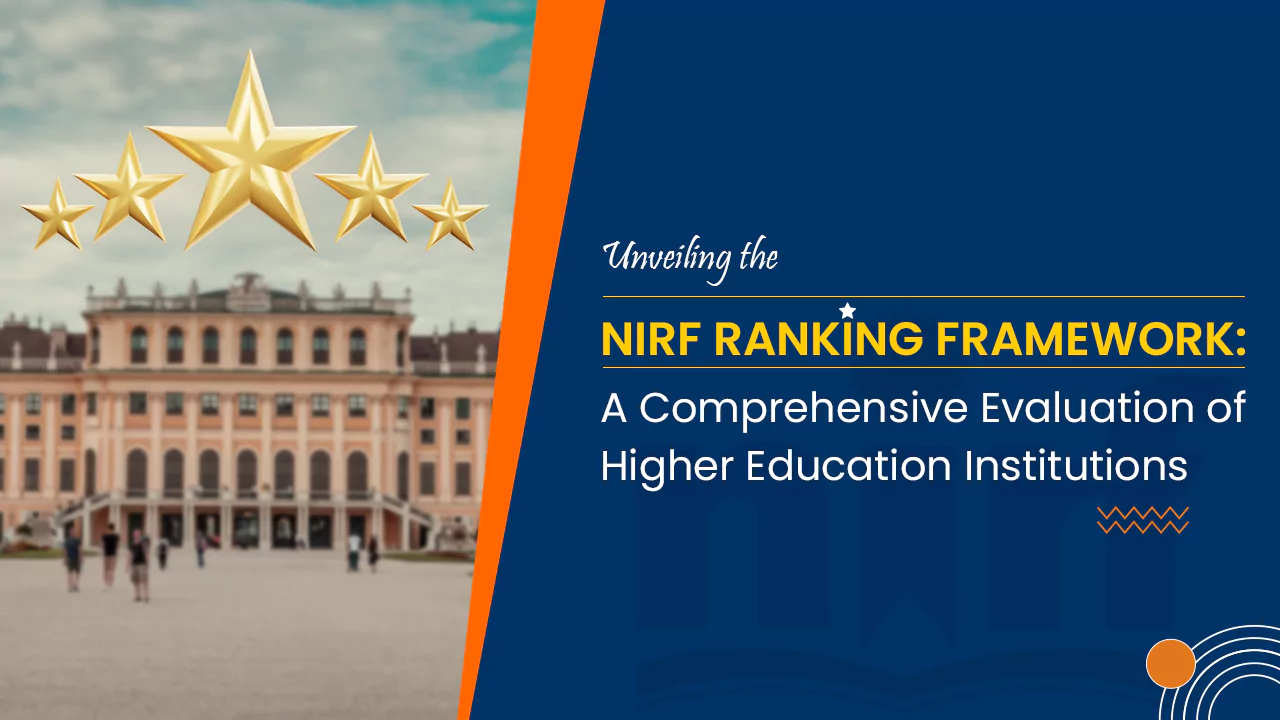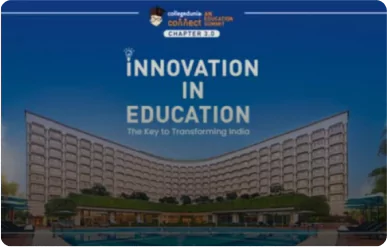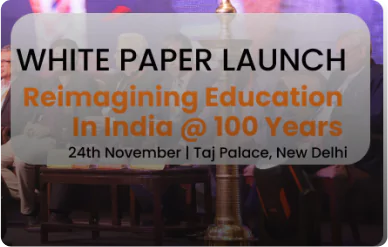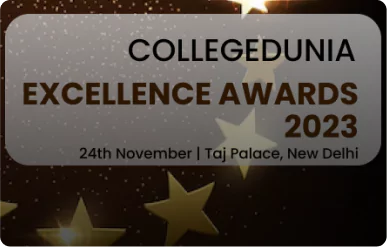In the book “A Brief History of Tomorrow”, Yuval Noah Harari suggests that data may become the new religion of human consciousness. In the Realm of Importance of Data, The Ministry of Education established the National Institutional Ranking Framework (NIRF) in 2016 to determine the critical indicators on which institutions’ performance could be measured. Released annually by the Ministry of Education, the NIRF rankings aim to provide valuable insights and assist students, parents, and stakeholders in making informed decisions about educational institutions
Understanding the NIRF Methodology & Parameters
Currently, the NIRF releases rankings across various categories: ‘Overall’, ‘Research Institutions’, ‘Universities’, and ‘Colleges’, and specific disciplines like engineering, management, pharmacy, law, etc.
The ranking framework judges these educational institutions under five broad generic groups of parameters of
- Teaching, Learning and Resources (TLR) (30% weightage),
- Research and Professional Practice (RP) (30% weightage),
- Graduation Outcomes (GO) (20% weightage),
- Outreach and Inclusivity (OI) (10% weightage) and
- Perception (PR) (10% weightage).
The Findings
- IIT-Madras topped the overall category for the fourth consecutive year, and in engineering for the seventh straight year.
- The top-ranked private institutions are Amrita Vishwa Vidyapeetham (16), Manipal Academy of Higher Education (17), Vellore Institute of Technology (18).
- The Indian Institute of Science (IISc) stood first in the research institutions category.
- AIIMs occupied the top slot in the medical education category for the fifth straight year.
- IIM-Ahmedabad remained the best institute in the management segment.
- The National Law School of India University, Bengaluru, retained the first position in law.
The Criticism
- Data fudging- The NIRF ranking shows that a private law university scored 100% in perception.
But the Common Law Admission Test admission choice shows that this institution figures below 10 NLUs as a preferred place to study.
- Overemphasis on bibliometrics: Experts have argued that bibliometric indicators don’t fully capture the intricacies of scientific performance.
*Bibliometrics refers to the measurable aspects of research, such as the number of papers published, the number of times they are cited, and the impact factors of journals.
- Lack of rigorous verification– There seems to be a lack of a rigorous system of verification by the NIRF of the data submitted by HEIs.
Regarding the faculty-student ratio (FSR), some private multi-discipline universities have claimed the same faculty in more than one discipline.
- Funds– Enormous funds have been claimed as expenditure on equipment for laboratories by some private multi-discipline institutions which offer law as a subject. But labs are not required for law.
- No transparency- The NIRF requires the data submitted to it be published by all the participating HEIs on their website so that such data can be scrutinised.
Some private multi-discipline universities have not granted free access to such data on their website.
There is also discrepancy in the data submitted to the NIRF and the data on the websites of these institutions.
- Methodology– The NIRF applies almost the same parameters to all the institutions across varied disciplines in research and professional practice.
There is a gap between the methodology employed for accreditation purposes and for ranking purposes.
While the National Assessment and Accreditation Council gives due weightage to publications in UGC-Care listed journals, the NIRF uses publication data only from Scopus and Web of Science
- Participation of institutions:The participation rate of institutions in the ranking process is relatively low, with only 12.3% of higher educational institutions submitting applications for ranking.
This raises concerns about the lack of information and recognition for the remaining 87.7% of institutions, particularly in a country with a large number of universities and colleges & for a nation aspiring to reap rich demographic dividend
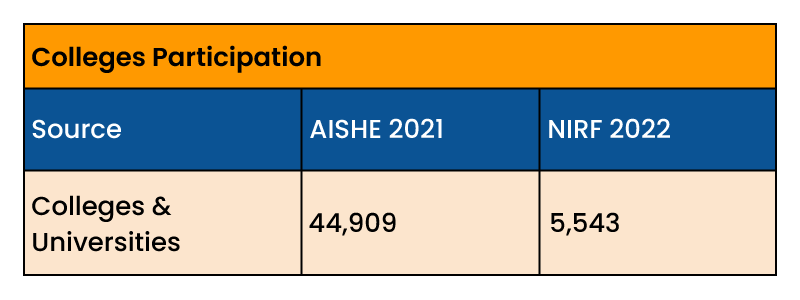
- Rural- Urban Divide in the Participation:
In the Top 100 Colleges shows scant presence of colleges from Rural areas, While AISHE data shows that 43% of Universities and 61.4% Colleges are in Rural Areas. This raises questions on inherent Urban bias reinforced by the choice of parameters.
- Incongruence between Quality & Quantity:The distribution of top-ranked colleges is heavily skewed towards a few states like Tamil Nadu, Delhi, and Kerala, while states with a high number of colleges like Uttar Pradesh do not have any representation in the top 100.
This indicates a need to focus on improving the quality of education across all states.
The discrepancy between private and government institutions is also notable, with private institutions securing lower ranks in the overall and university rankings.
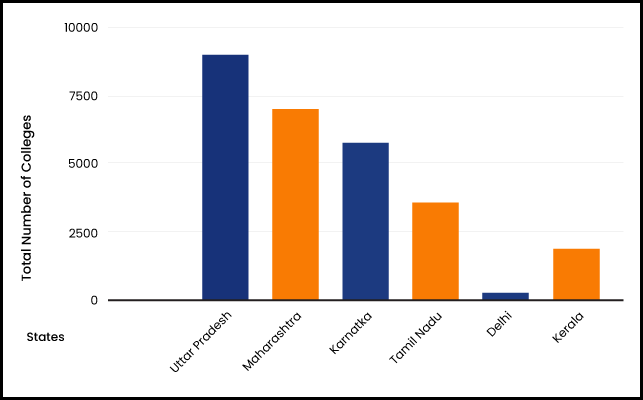
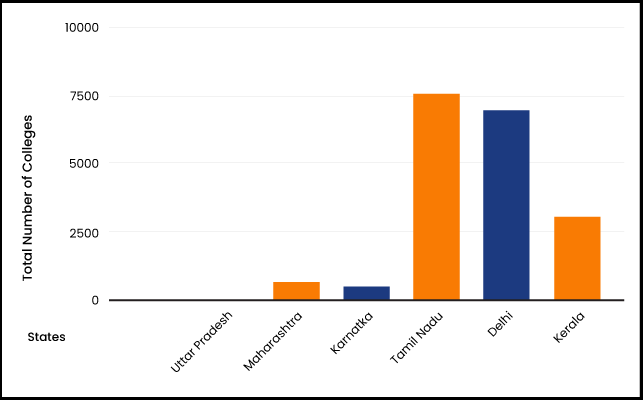
Depicting the Top states with maximum number of colleges and their representation in the top 100 institutions of NIRF Ranking
- Quality Difference Between Private and Government Institutions:
The discrepancy between private and government institutions is also notable, with private institutions securing lower ranks in the overall and university rankings.
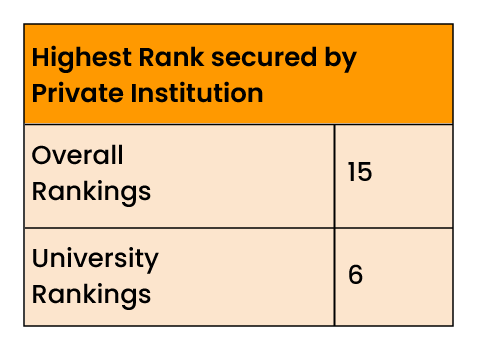
- Lack of adherence to the AICTE prescribed Faculty-Student Ratio of 1:20:
The rankings demonstrate a strong correlation between faculty strength and institutional rankings.
Top-ranked universities and colleges tend to have a significantly higher number of faculty members compared to lower-ranked institutions.
This suggests that quality education is not solely dependent on infrastructure but also on the presence of qualified faculty members.
It also highlights the non-compliance of many engineering institutions with the prescribed faculty-student ratio by the All India Council for Technical Education (AICTE).

- Uneven distribution of the Scientific Publications:
A significant portion of scholarly output in India, approximately 87.71%, comes from the institutions that participated in the NIRF rankings.
This means that a small percentage (12.3%) of institutions that took part in the rankings contribute to a large proportion (close to 90%) of the country’s scholarly output.
In the field of engineering, an even higher percentage (99.98%) of scientific publications are generated by the institutions that participated in the rankings. On the other hand, in the management domain, 50% of the institutions that applied for rankings had zero publications, indicating a lack of research output.
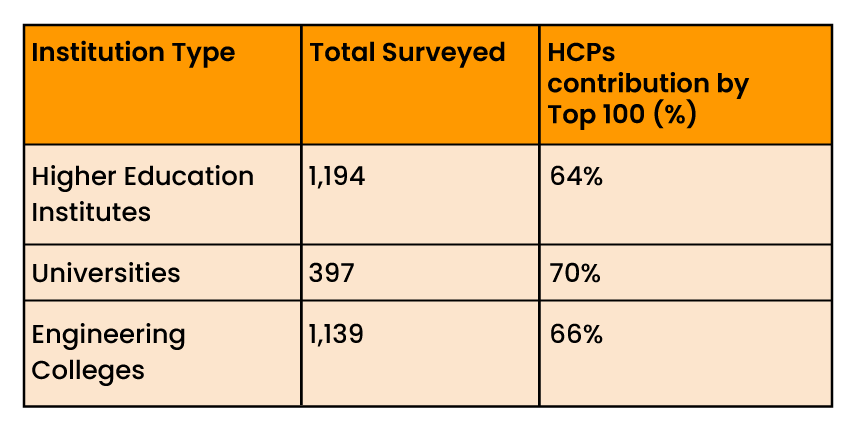
The Repercussions
- Misleading prospective students and parents about the quality and reputation of institutions.
- Creating unfair competition and incentives among institutions to game the system.
- Undermining the credibility and usefulness of the ranking framework.
- Neglecting other aspects of institutional excellence, such as innovation, diversity, social impact, etc.
- May negatively affect the perception, reputation, and competitiveness of foreign educational institutions if they set up their campuses in India.
The Scope of Improvement
- Nurturing faculty research output by providing adequate resources, incentives, and recognition.
- Bibliometrics should not be used as the sole criteria for any evaluative purpose. They should always be combined with other forms of evaluation, such as peer review, to make informed decisions.
- Creating an institutional repository to showcase and disseminate the research publications and impact.
- Improving the teaching-learning process by creating an outcome-based curriculum, using innovative pedagogies, and ensuring student feedback and satisfaction.
- Enhancing the graduation outcomes by improving the placement, entrepreneurship, and higher education opportunities for students.
- Promoting outreach and inclusivity by increasing the diversity of students, faculty, and staff, and engaging with the local and global communities.
- NIRF Rankings ought to be transparent about what data they collect, how they collect it, and how that data becomes the basis for the total score.
The Guide to Improve NIRF Ranking
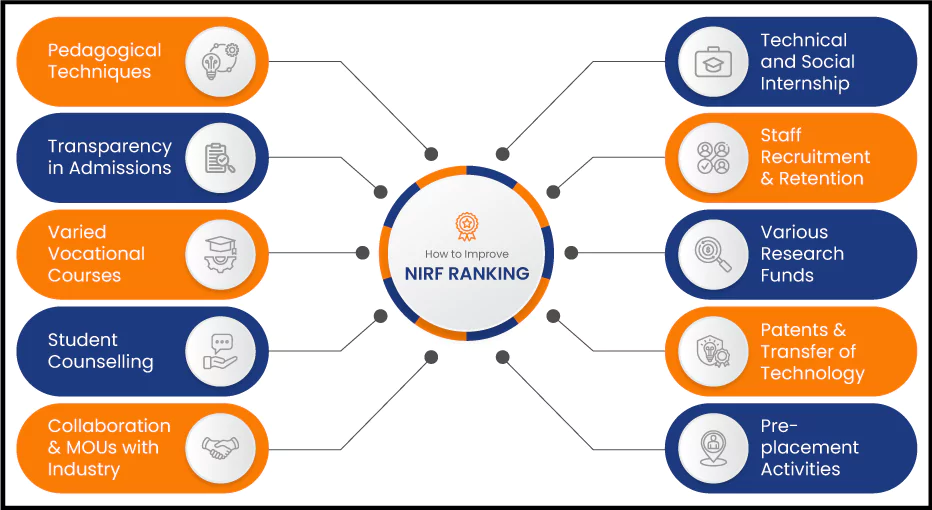
The following are some best practises that can help raise the NIRF ranking:
- Latest Educational Methods
Familiarity with recent educational methods elevates the quality of education at the institute. - Transparent Admissions
Promoting transparency in admissions procedures increases parental confidence in the institution. - Diverse Curriculum
Including multidisciplinary and interdisciplinary courses expands students’ opportunities and enhances the institution’s reputation. - Student Counselling
Student counselling is a valuable support service for students, assisting them in their personal and career development. - Vocational Courses (Full-Time or Part-Time)
Offering vocational courses alongside core subjects equips students with specialised skills, opening doors to opportunities and recognition. - Collaboration with Industry, Research Organizations, and Eminence Institutes
Expanding the institute’s network through collaborations benefits its reputation. Partnerships with research organisations showcase contributions to research and development. Collaborating with renowned institutions spreads awareness about the institute’s activities. - Technical and Social Internships: 2 Weeks, 4 Weeks, 6 Months
Conducting technical internships of varying durations helps students gain knowledge and employment prospects. Social internships provide hands-on experience in case management, assessment, and community service. - Staff Recruitment: Ph.D. Qualifications, Retention, Balanced Gender Ratio
Recruiting teachers/professors with Ph.D. qualifications and ensuring a supportive environment for enriched teaching and learning. Maintaining a balanced gender ratio among staff and students is essential to prevent discrimination. - Research Funding, Seed Money, Consultancy
Applying for research funds supports ongoing research and developmental activities. Participation in educational events and expos attracts potential investors. Consultancy services foster collaboration and attract like-minded individuals. - Patents and Technology Transfer
Securing patents safeguards research and inventions. Technology transfer involves sharing research data, know-how, and materials, following legal guidelines and protocols.
Pre-Placement Activities, Placement Assistance, Post-Placement Support
Institutes play a vital role in enhancing students’ abilities through value-based education and career opportunities. Pre-placement activities, placement assistance, and post-placement support facilitate a smooth transition to the workforce, helping students explore alternative career paths if needed.

